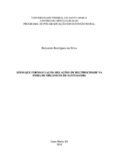| dc.creator | Silva, Bernardo Rodrigues da | |
| dc.date.accessioned | 2018-09-12T16:01:39Z | |
| dc.date.available | 2018-09-12T16:01:39Z | |
| dc.date.issued | 2018-02-27 | |
| dc.identifier.uri | http://repositorio.ufsm.br/handle/1/14281 | |
| dc.description.abstract | This dissertation looked for to understand the reciprocity relationships in the Organic Fair of the city of Santiago / RS and their respective influences on consumption habits. For this, it was searched to contextualize the organic farmers and the reason why they led them to produce and market organic; to interpret the meanings built by organic farmers in the daily life of the fair; to identify reciprocity relations in the context of the fair; and, to construct a photoetnographic narrative of the food path, from the harvest to the final consumer. Thus, four families of “organic farmers” were presented, observing points related to the cultures in which they are inserted and the relationships derived from them. The research presented a qualitative approach and was developed through several techniques of data collection, among them, interview, observation and photography are cited as primary data, and bibliographical and documentary research as secondary data. With the study, it was perceived how it was occur the historical dynamics of the organization of the fair, reaching the current marketing strategies of farmers, through the meanings built through the daily life in which these studied families are inserted, from before the fair, to the moment in consumption and relations between farmers and consumers takes form. In the first five chapters the narrative of the dissertation is presented through textual resources and in the fifth chapter it presents itself through imagery resources. All the research looked for to capture the work and relationships that occur around the food, leading the reader from the place of production and processing to the consumer, thus, the farmers presented themselves as meaning trainers through the view captured by photographic lenses. | eng |
| dc.description.sponsorship | Coordenação de Aperfeiçoamento de Pessoal de Nível Superior - CAPES | por |
| dc.language | por | por |
| dc.publisher | Universidade Federal de Santa Maria | por |
| dc.rights | Attribution-NonCommercial-NoDerivatives 4.0 International | * |
| dc.rights.uri | http://creativecommons.org/licenses/by-nc-nd/4.0/ | * |
| dc.subject | Agricultura orgânica | por |
| dc.subject | Feiras livres | por |
| dc.subject | Cultura | por |
| dc.subject | Reciprocidade | por |
| dc.subject | Fotoetnografia | por |
| dc.subject | Organic agriculture | eng |
| dc.subject | Free fairs | eng |
| dc.subject | Culture | eng |
| dc.subject | Reciprocity | eng |
| dc.subject | Photoetnography | eng |
| dc.title | Mãos que formam laços: relações de reciprocidade na feira de orgânicos de Santiago/RS | por |
| dc.title.alternative | Hands forming ties: reciprocity relations in the organics farmers market of Santiago /RS | eng |
| dc.type | Dissertação | por |
| dc.description.resumo | Esta dissertação buscou compreender, a partir da visão dos feirantes as relações de reciprocidade na Feira de Orgânicos do município de Santiago / RS. Para isso se buscou contextualizar a história dos feirantes e o motivo pelo qual os levaram a produzir e comercializar alimentos orgânicos; interpretar os significados construídos por feirantes no cotidiano da feira; identificar as relações de reciprocidade no contexto da feira; e, construir uma narrativa fotoetnográfica do caminho do alimento, da colheita ao consumidor final. Assim foram apresentadas quatro famílias de “agricultores orgânicos”, observando pontos relacionados às culturas em que estão inseridas e as relações delas derivadas. A pesquisa apresentou uma abordagem qualitativa e foi desenvolvida através de diversas técnicas de coletas de dados, dentre elas, cita-se a entrevista, a observação e a fotografia, como dados primários, e a pesquisa bibliográfica e documental, como dados secundários. Com o estudo percebeu-se como se deu a dinâmica histórica da organização da feira, chegando às estratégias atuais de comercialização dos agricultores, passando por significações construídas através do cotidiano em que estas famílias estudadas estão inseridas, desde antes da feira, até o momento em que ocorre o consumo e as relações entre agricultores e consumidores toma forma. Nos primeiros cinco capítulos a narrativa da dissertação se apresenta através de recursos textuais e no quinto capítulo ela se apresenta através de recursos imagéticos. Toda a pesquisa buscou captar o trabalho e as relações que ocorrem em torno do alimento, conduzindo o leitor do local da produção e processamento até o consumidor, assim, os agricultores se apresentaram enquanto formadores de significado através do olhar captado por lentes fotográficas. | por |
| dc.contributor.advisor1 | Wizniewsky, José Geraldo | |
| dc.contributor.advisor1Lattes | http://lattes.cnpq.br/8502017453675807 | por |
| dc.contributor.referee1 | Guimarães, Gisele Martins | |
| dc.contributor.referee1Lattes | http://lattes.cnpq.br/5761884963281404 | por |
| dc.contributor.referee2 | Balem, Tatiana Aparecida | |
| dc.contributor.referee2Lattes | http://lattes.cnpq.br/6538418369078880 | por |
| dc.creator.Lattes | http://lattes.cnpq.br/6861723233393507 | por |
| dc.publisher.country | Brasil | por |
| dc.publisher.department | Agronomia | por |
| dc.publisher.initials | UFSM | por |
| dc.publisher.program | Programa de Pós-Graduação em Extensão Rural | por |
| dc.subject.cnpq | CNPQ::CIENCIAS AGRARIAS::AGRONOMIA::EXTENSAO RURAL | por |
| dc.publisher.unidade | Centro de Ciências Rurais | por |



